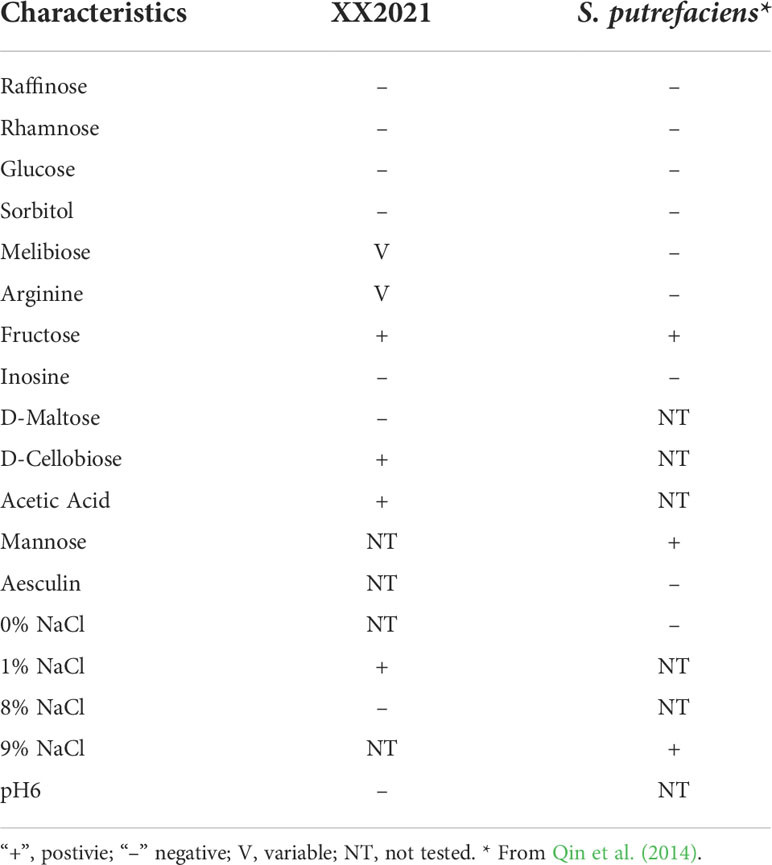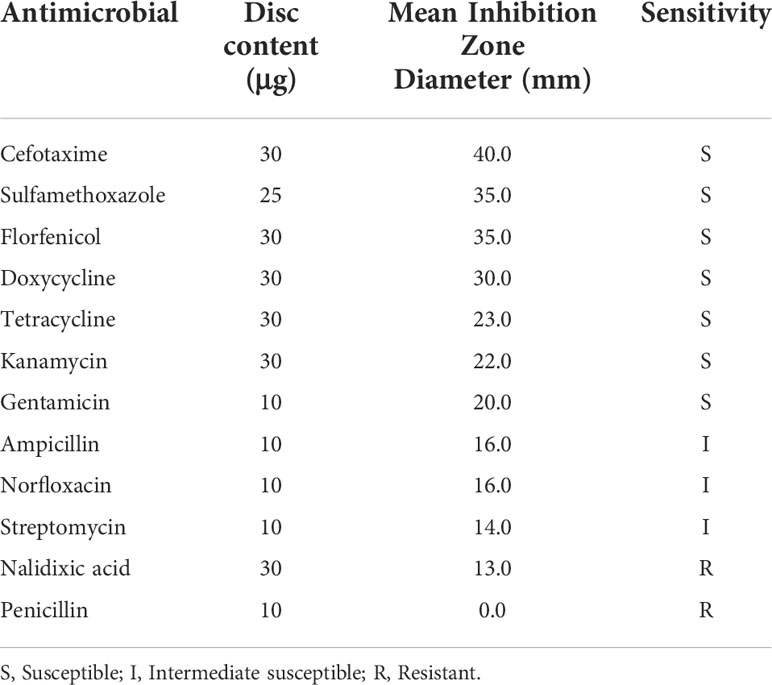- Engineering Lab of Henan Province for Aquatic Animal Disease Control, College of Fisheries, Henan Normal University, Xinxiang, China
The largemouth bass (Micropterus salmoides) is an economically important aquaculture species in China, and its production has increased rapidly in recent years. Although Shewanella putrefaciens is known to infect several fish species, its role in infecting M. salmoides is relatively unknown. Here, we isolated a gram-negative bacterial strain (termed XX2021) from farmed largemouth bass. Based on the results of 16S rRNA sequencing and phylogenetic analyses, the isolate was identified as S. putrefaciens. The virulence of XX2021 was dependent on water temperature, such as the LD50 values were 4.21×104, 7.26×105, and 2.47×106 CFU/g fish weight at 10°C, 18°C, and 25°C, respectively. Four virulent genes—including dksA, hem, lonR, and fur—were screened through a PCR assay. The results of an antibiotic resistance test showed that XX2021 was sensitive to kanamycin, cefotaxime, doxycycline, sulfamethoxazole, florfenicol, tetracycline, and gentamicin; showed intermediate susceptibility to streptomycin, ampicillin, and norfloxacin; and was resistant to nalidixic acid and penicillin. XX2021-infected fish showed clinical symptoms typical of S. putrefaciens infection. In addition, we re-isolated XX2021 from infected fish and confirmed its identity using 16S rRNA sequencing. Histopathological changes were observed in the intestine, head kidney, spleen, and liver of diseased fish. This study presents the first report of the pathogenic effects of S. putrefaciens in farmed largemouth bass. Our findings may help develop effective disease control strategies for aquaculture fish and prevent disease outbreaks under low water temperatures.
Introduction
Shewanella putrefaciens is a non-fermentative, motile, gram-negative bacillus with chief phenotypic attribute of H2S production (Holt et al., 2005). The species belongs to the genus Shewanella, named after the microbiologist James Shewan who had made outstanding contributions to the field of marine microorganisms (MacDonell and Colwell, 1985). In mammals, Shewanella spp. are associated with various infections—such as ear, skin, and soft tissue infections—and bacteremia (Holt et al., 2005; Janda, 2014). Shewanella putrefaciens is also known as an important spoilage bacterium of seafood (Jia et al., 2018; Liu et al., 2018; Jia et al., 2019). Previous studies have reported Shewanella spp. infections in several aquatic animals such as European sea bass (Dicentrarchus labrax), loach (Misgurnus anguillicaudatus), common carp (Cyprinus carpio), rainbow trout (Oncorhynchus mykiss), goldfish (Carassius auratus auratus), European eel (Anguilla anguilla), American eel (Anguilla rostrata), and tilapia (Oreochromis niloticus) (Kozinska and Pekala, 2004; Korun et al., 2009; Lu and Levin, 2010; Qin et al., 2014; Turgay et al., 2014; Pękala et al., 2015; Wang et al., 2020). The infected tilapia showed skin hemorrhage, fin rot and shallow necrotizing ulcers on the skin with congestion and enlargement of the liver, spleen and kidneys (Manal, 2017). However, the role of S. putrefaciens in causing diseases in aquaculture is poorly understood.
Largemouth bass (Micropterus salmoides) are native to North America. In the past few years, this species has become an economically important freshwater aquaculture fish in China (Bai et al., 2008; Li et al., 2017). China produced 619, 519 t of largemouth bass in 2020, increased almost 30% of its total production than that in 2019. The occurrence of disease outbreaks in Chinese aquacultures has become more frequent in recent years, causing considerable damage to the aquaculture of largemouth bass (Ma et al., 2013). In March 2021, largemouth bass being cultured in Henan Province experienced persistent mortalities at a water temperature of approximately 10°C. The clinical symptoms of the affected individuals were indicative of a bacterial disease. In this study, we isolated a strain of S. putrefaciens (termed XX2021) from diseased largemouth bass and identified it as the main pathogen. We also evaluated the sensitivity of XX2021 to 12 antibiotics and examined the histopathological changes in the intestines, head kidney, liver, and spleen in diseased fish. To the best of our knowledge, this is the first study to report S. putrefaciens as a pathogen of largemouth bass. Our results provide a reference for the prevention and treatment of the diseases caused by S. putrefaciens infection in largemouth bass under low temperatures.
Materials and methods
Fish
Thirty diseased fish (100 ± 12 g) cultured in three ponds (13,333 m3/pond; 40,000–45,000 fish/pond) were randomly selected for this study. The fish were transported in ice boxes to the laboratory for diagnosis and anesthetized with MS-222, following which the pathogen was isolated. Healthy fish (n = 360, 15 ± 2 g) were purchased from a local bass farm. Largemouth bass were acclimatized in aerated tanks at 25 ± 2°C for 14 d. The water temperature was decreased by 2°C per day until it reached 10°C or 18°C. The lethal dose 50 (LD50) of the pathogen (XX2021) was measured at different water temperatures. For tissue sampling, fish were anaesthetized with MS-222 (40 mg/L, Sigma-Aldrich).
Isolation and identification of the pathogen
Bacteria were isolated from spleen and muscle tissue of diseased largemouth bass. The isolates were streaked on LB agar medium, followed by incubation at 28°C for 36 h, and the dominant isolated bacteria were re-streaked on the medium three times.
Total genomic DNA was extracted from isolates using bacterial DNA extraction kits (Sangon Biotech, China). The universal primers (27F: 5’-AGAGTTTGATCCTGGCTCAG-3’ and 1492R: 5’TACGGCTACCTTGTTACGACTT-3’) were used for PCR amplification of the bacterial 16S rRNA gene (Weisburg et al., 1991).
Selected 16S rRNA sequences of Shewanella spp. were aligned using CLUSTAL multiple alignment in MEGA 5.0. The neighbor-joining method was used to construct a phylogenetic tree after bootstrapping (10,000 replicates). The JTT matrix-based method was used for tree construction. All positions in the alignment that contained gaps or eliminated data after pairwise sequence comparisons (pairwise deletion) were removed, as described previously (Jiang et al., 2016).
Phenotypical characterization
The physiological and biochemical identification of XX2021 was performed as described previously (Yuan et al., 2021). The Biolog GenIII MicroPlate technique (protocol B, Biolog) was used for this experiment, and final results were recorded at 24 and 48 h of incubation. The physiological and biochemical characteristics of XX2021 could be identified by the phenotypic fingerprint shown on the Biolog GenIII MicroPlate system. The morphology of the bacteria was examined with Gram staining and observation under a scanning electron microscope with the method discribed by Aid et al. (2020). The hemolytic activity of the bacteria was determined using the blood agar plate method. Briefly, the bacteria were inoculated on the medium containing 5% sheep blood. After 36 h of incubation at 28°C, hemolytic isolates were identified based on the presence of α- or β-hemolysis around the colonies.
Antimicrobial sensitivity testing
Antimicrobial sensitivity was tested as previously described (Pei et al., 2021). In brief, S. putrefaciens strain XX2021 was spread on Muller–Hilton agar medium, and different kinds of antimicrobial discs were placed on the streaked cultures. Discs containing streptomycin (10 μg), sulfamethoxazole (25 μg), florfenicol (30 μg), doxycycline (30 μg), tetracycline (30 μg), kanamycin (30 μg), gentamicin (10 μg), nalidixic acid (30 μg), norfloxacin (10 μg), cefotaxime (30 μg), ampicillin (10 μg), and penicillin (10 μg) were used. After 24 h of incubation at 28°C, the diameters of inhibition zones around the discs were measured. The bacteria were classified as susceptible (S), intermediate susceptible (I), or resistant (R), based on the guidelines of the National Committee for Clinical Laboratory Standards.
Infection test and detection of virulence genes
To determine whether the disease was caused by XX2021, we performed an infection test in healthy largemouth bass as described previously (Pei et al., 2021). Bacterial concentrations were determined by plating 10-fold serial dilutions of the isolates onto LB plates. To examine the LD50 of XX2021 at different water temperatures, largemouth bass were randomly divided into three groups (120 fish/group) and acclimatized to different temperatures. Each group was further divided into six subgroups, including five infection subgroups and one control subgroup (20 fish/subgroup). Infection groups were injected intraperitoneally with XX2021 at a concentration of 102–106 CFU/g fish weight in 10-fold increments. The control groups were injected with an equal dose of sterile phosphate-buffered saline. The experiment was performed twice. The mortality of fish was monitored for 7 d, and LD50 was determined using probit regression analysis in SPSS 20.0 (SPSS Inc., IBM Corp., USA). The bacteria were re-isolated and re-identified from infected largemouth bass. Twelve potential virulence genes in Shewanella spp. were detected from the genomic DNA of XX2021 with specific primers (Table 1) (Saticioglu et al., 2021).
Histological examination
Histological examination was performed as described previously (Pei et al., 2021). Tissues collected from the spleen, liver, head kidney, and intestines of control and XX2021-injected fish were fixed with 4% paraformaldehyde for 12 h, submerged in 70% alcohol, dehydrated in tertiary butyl alcohol (10%–100%), and embedded in paraffin. Thereafter, paraffin-embedded tissues were cut into 5-μm-thick sections using a microtome (Thermo HM340E, American) and then stained with hematoxylin and eosin. The histological slides were examined with a light microscope (Olympus BX51, Japan).
Results
Clinical signs and symptoms
In diseased largemouth bass obtained from the local farm, the clinical symptoms included hemorrhage in the abdomen (Figure 1A) and ulceration on the back and abdomen (Figures 1B, C). The diseased fish also showed appetite loss and sluggish behavior (slow swimming and weak reactions to stimuli). Healthy largemouth bass infected with the isolated bacteria showed symptoms similar to the infected fish in the natural.
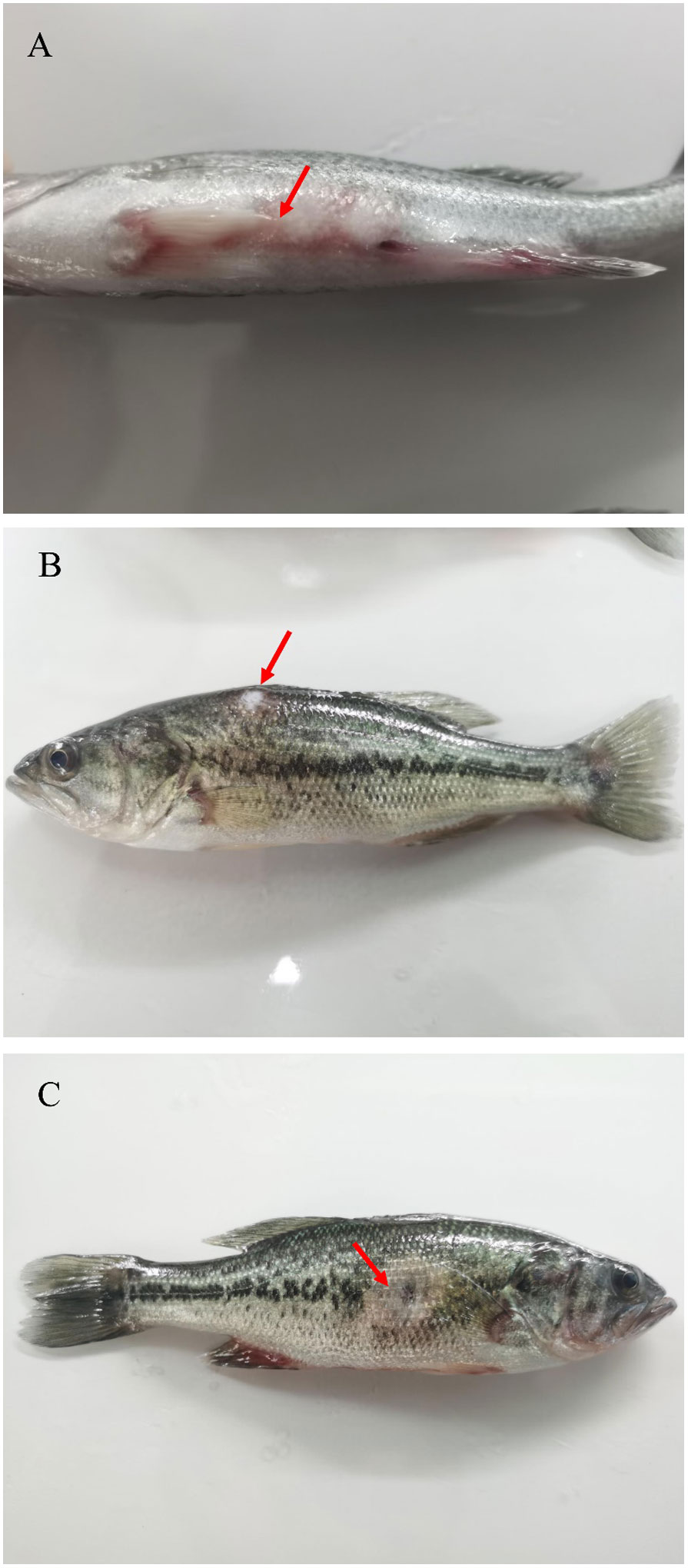
Figure 1 Clinical symptoms of XX2021-infected largemouth bass. (A) Hemorrhage in the abdomen (red arrow); (B) Ulceration on the back (red arrow); (C) Ulceration on the abdomen (red arrow).
Morphological and molecular characteristics of the bacterial pathogen
Upon Gram staining, the isolated bacteria (XX2021) were found to be gram-negative under optical microscopy (Figure 2A). When observed under a scanning electron microscope, most isolated bacteria were rod-shaped and lacked flagella. The diameter of the isolated bacterium was approximately 0.8 μm (Figure 2B). The colonies on LB plates were buff, circular, convex, and light red in color. The BLAST analysis revealed that the 16S rRNA gene of XX2021 shared the highest similarity (99.7%) with that of the S. putrefaciens strain (accession number: NR119141.1). A phylogenetic tree was constructed based on the 16S rRNA amino acid sequences of Shewanella spp., and XX2021 clustered together with S. putrefaciens (accession number: NR119141.1) (Figure 3).
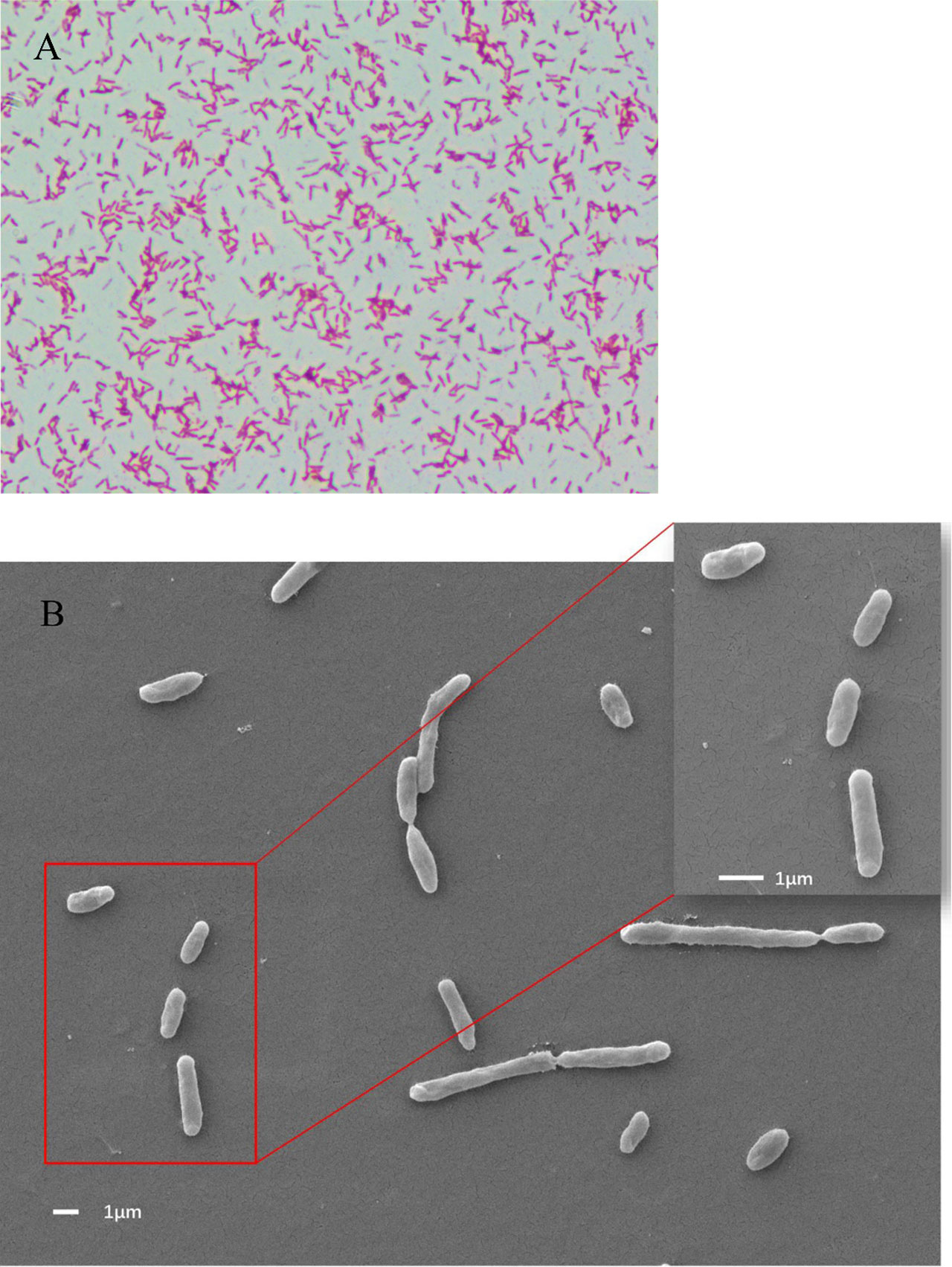
Figure 2 Morphology of XX2021 observed under an optical microscope at 100× magnification and a scanning electron microscope. (A) Bacteria (XX2021) were found to be gram-negative under optical microscopy; (B) Most isolated bacteria were rod-shaped and lacked a flagellum. The diameter of XX2021 was approximate 0.8 μm.
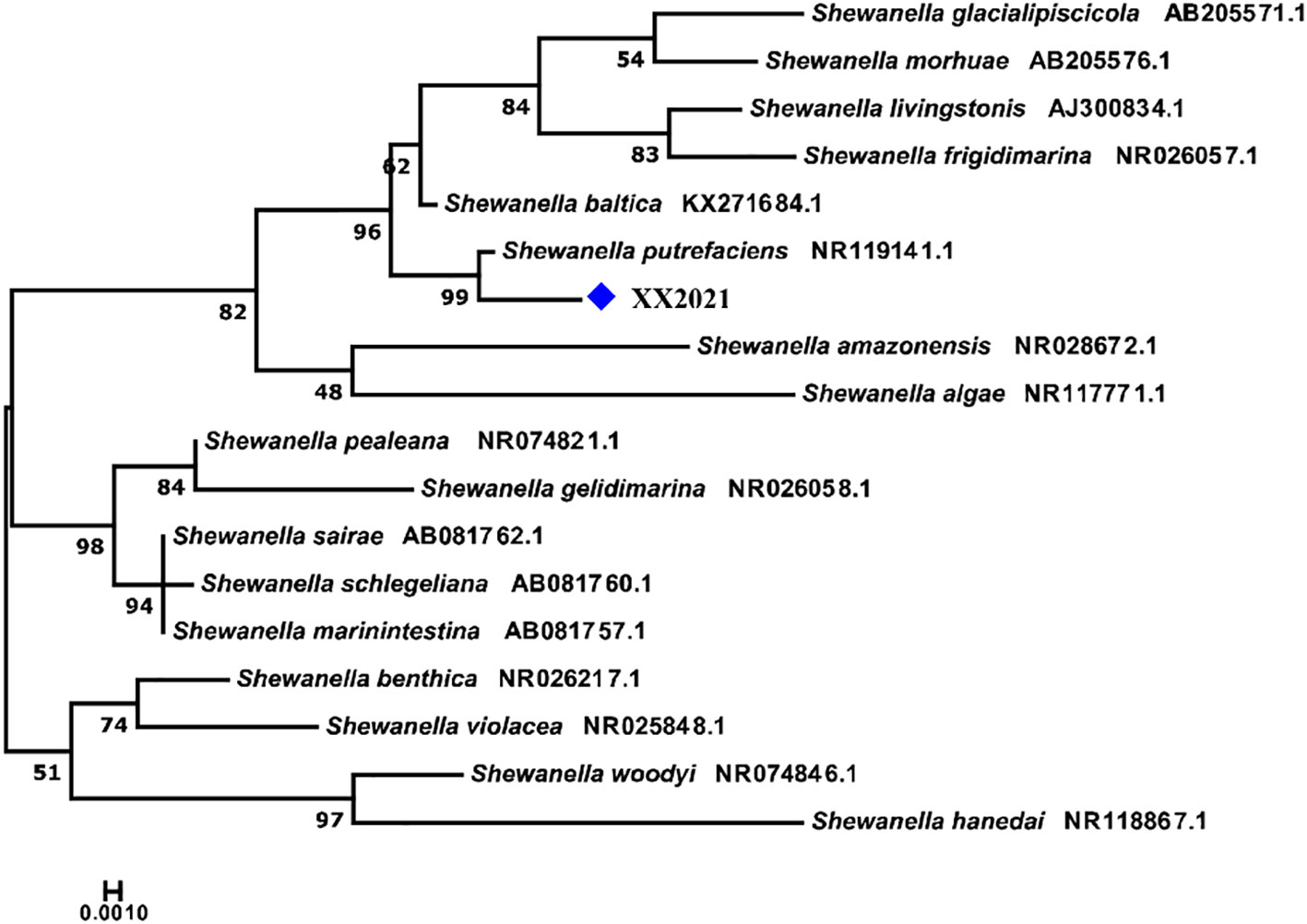
Figure 3 Neighbor-joining (NJ) phylogenetic tree constructed based on the 16S rRNA nucleotide sequences of Shewanella species. The percentage of bootstrap values is shown next to the branches based on 10,000 bootstrap replications. The XX2021 sequence is indicated by the blue square.
The physiological and biochemical test results indicated that the bacterial isolate showed positive biochemical reactions for fructose and could grow on a substrate containing 1% (but not 8%) NaCl. It showed negative reactions for raffinose, glucose, sorbitol, rhamnose, and inosine. The substrate utilization patterns and biochemical profiles of XX2021 and S. putrefaciens are listed in Table 2. Based on these results, we identified the isolated bacteria (XX2021) as S. putrefaciens.
Evaluation of virulence at different temperatures and analysis of virulence genes
To examine the effect of temperature on the virulence of XX2021, we performed an infection test in healthy largemouth bass. Following injection with the pathogen, the fish mostly died on days 2–6. The highest cumulative mortality rate was 65% when fish were injected with bacteria (concentration, 106 CFU/g fish weight) at 10°C (Figure 4). The LD50 of XX2021 was 4.21×104, 7.26×105, and 2.47×106 CFU/g fish weight at 10, 18, and 25°C, respectively. We also identified 12 potential virulence genes using the PCR method; the virulence genes lonR, dksA, hem, and fur were screened out (Figure 5). The isolates did not exhibit α- or β-hemolysis on sheep blood agar (Figure S).
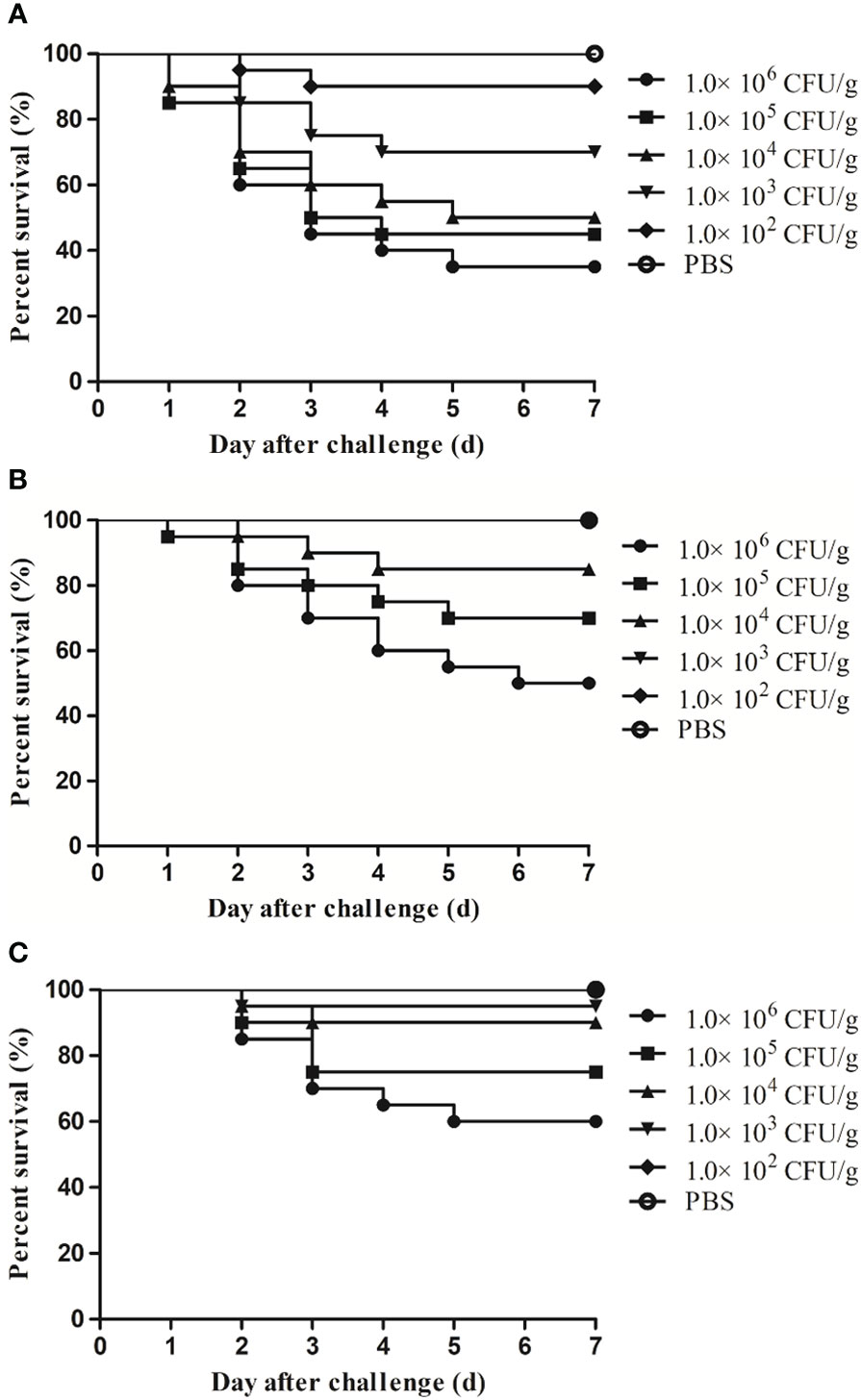
Figure 4 Survival rates of largemouth bass challenged by various doses of XX2021 at different water temperatures during the first 7 days post infection. (A) 10°C; (B) 18°C; (C) 25°C.
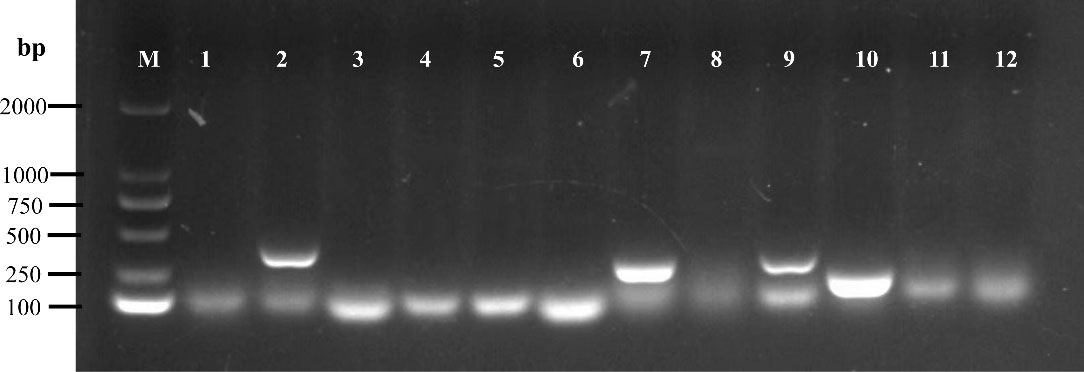
Figure 5 Agarose gel electrophoresis of the PCR products of virulence genes. M: DL2000 marker. Lane 1: nqrF, 2: lonR, 3: atpA, 4: guaA, 5: lux, 6: crp, 7: dksA, 8: exu, 9: hem, 10: fur, 11: ompR, 12: fla.
Determination of antibiotic resistance
We examined antimicrobial resistance and susceptibility patterns of XX2021 by measuring the diameter of the zone of inhibition around each antibiotic disc. The isolate was susceptible (S) to cefotaxime, sulfamethoxazole, florfenicol, doxycycline, tetracycline, kanamycin, and gentamicin; showed intermediate susceptibility (I) to ampicillin, norfloxacin, and streptomycin; and was resistant (R) to nalidixic acid and penicillin (Table 3).
Histopathology
Histopathological examination showed that the intestines, head kidney, spleen, and liver exhibited well-organized structures in the control group (Figures 6A–D). However, the XX2021-infected group had fewer goblet cells, and exhibited cell degeneration and epithelium vacuolization with vagueness of the cuticula in the intestine (Figure 6a). Numerous inflammatory cells had infiltrated the head kidney (Figure 6b), and abundant hemosiderin granules (yellow-brown pigment) were observed in the spleen of infected fish (Figure 6c). The tissues of infected fish also showed serious vacuolization of cells, clearly pyknotic nuclei, and an increased number of Kupffer cells in the liver (Figure 6d).

Figure 6 Histological changes in largemouth bass challenged by the XX2021 strain. (A-D) are the intestines, head kidney, spleen, and liver of a healthy fish, respectively; (a) Goblet cell absence (black arrow), epithelium vacuolization (red arrow), and cell degeneration and vagueness of the cuticula (the area circled in red) in the intestine. (b) Head kidney infiltrated by numerous inflammatory cells (the area circled in red). (c) Abundant hemosiderin granules (red arrows) in the spleen. (d) Serious vacuolization of cells (black arrow), clearly pyknotic nuclei (blue arrow), and an increased number of Kupffer cells (red arrows) in the liver.
Discussion
In this study, we isolated and identified a bacterium (XX2021) from diseased largemouth bass. Physiological and biochemical analyses demonstrated that XX2021 had phenotypic properties consistent with those of S. putrefaciens. This is the first recording of a S. putrefaciens strain as a pathogen of largemouth bass. The XX2021 isolate was gram-negative, and most cells were rod-shaped and lacked a flagellum (Figures 1A, B). Shewanella putrefaciens strains isolated from seawater samples in Denmark have been characterized as non-fermentative bacilli with a single polar flagellum (Holt et al., 2005). A highly pathogenic bacterium (AP629) belonging to Shewanella spp. was isolated from a sea cucumber (Apostichopus japonicus), and these cells were also characterized as short bacilli with a single polar flagellum (Li et al., 2010). Notably, S. putrefaciens strains with a flagellum have been detected at water temperatures above 13°C (Gram et al., 1999). In humans, Shewanella infections are most common during especially warm summers or in countries with a warm climate (Holt et al., 2005). In this study, XX2021 was isolated from largemouth bass acclimatized to a water temperature of approximately 10°C. Our results are consistent with those of Manal (2017), who isolated a strain of S. putrefaciens from O. niloticus during the winter season. Moreover, XX2021 was isolated from fresh water and could grow in 1% (but not 8%) NaCl (Table 2). In contrast, S. putrefaciens strains with a flagellum have been isolated from seawater, which has a higher NaCl concentration than freshwater (Holt et al., 2005). These results indicate that S. putrefaciens strains isolated from freshwater or seawater may have different phenotypes due to adaptation to their living environment.
Shewanella putrefaciens is a type of zoonotic pathogen. In humans, the most common clinical symptom of S. putrefaciens infection occur on the skin or in soft tissue (Ryan et al., 2018; Patel et al., 2020; Benaissa et al., 2021). In this study, infected largemouth bass exhibited several clinical symptoms, including loss of appetite, slow swimming, ulceration on the back and abdomen, and hemorrhage in the abdomen (Figure 1). Similar symptoms have also been reported in tilapia, carp, goldfish, and trout infected by S. putrefaciens (Kozinska and Pekala, 2004; Turgay et al., 2014; Manal, 2017).
The antimicrobial susceptibility test showed that XX2021 was susceptible to sulfamethoxazole, tetracycline, gentamicin, and florfenicol. Similar results havebeen reported by Altun et al. (2014) and Manal (2017). A strain of S. putrefaciens isolated from diseased sea bass was found to be resistant to sulfonamides and tetracycline (Korun et al., 2009). Moreover, although a strain of S. putrefaciens isolated from tilapia showed susceptibility to norfloxacin and streptomycin (Manal, 2017), XX2021 showed intermediate susceptibility to these two antibacterial agents. XX2021 also showed complete resistance to both nalidixic acid and penicillin, Therefore, these anti-infection agents should be withdrawn from the therapeutic plan of fish infected by S. putrefaciens.
Shewanella putrefaciens is a pathogenic bacterium that has been isolated from both marine and freshwater fish (Korun et al., 2009; Qin et al., 2014). Infected fish exhibit emaciation, a distended anus, ulceration on the back and abdomen, and hemorrhage in the abdomen (Pękala et al., 2015). However, one strain of S. putrefaciens (SpPdp11) isolated from the skin of healthy gilthead seabream (Sparus aurata) has been used as a probiotic. Dietary administration of live SpPdp11 has been shown to significantly increase the expression levels of IgM and protease, the activity of cellular peroxidase, and respiratory burst activity (Varela et al., 2010; Tapia-Paniagua et al., 2014; Cerezuela et al., 2016; Cámara-Ruiz et al., 2020).
Globally, S. putrefaciens is known as an important spoilage microorganism of fish during cold storage (Yan and Xie, 2020). Here, we found that the LD50 of XX2021 was related to the water temperature, such that the virulence of the isolate was higher at 10°C than at 25°C. This suggests that temperature is a key factor affecting the virulence of S. putrefaciens. Similar results have been reported in the channel catfish (Ictalurus punctatus), which is farmed in North America. Specifically, S. putrefaciens has been shown to infect these fish at water temperatures below 10°C (Mohammed and Peatman, 2018). However, in aquacultures, the optimum temperature for infection by most bacteria is higher than 18°C. Some studies have reported that S. putrefaciens can attach to biotic or abiotic surfaces to form biofilms, which contribute to the degradation of seafood quality. The formation of biofilms is promoted at low temperatures, and they protect bacteria from adverse environmental conditions, including the low temperatures (Bagge et al., 2001; Yan and Xie, 2020). These findings suggest that S. putrefaciens can infect fish at low water temperatures.
In this study, we detected 12 potential virulence genes in Shewanella spp. Of these, four were found in the genome of XX2021. Thereinto, dksA encods the RNA polymerase binding transcription factor, and fur regulates the intracellular iron transport, storage and utilization in Gram-negative bacteria. These virulence genes provide the basis for follow-up studies on vaccine development and pathogenesis research. In addition, the tissues of XX2021-injected largemouth bass showed histopathological changes in the intestine, head kidney, spleen, and liver (Figure 6). Tissue degeneration was likely caused by bacterial toxins. Kupffer cells are involved in the pathogenesis of liver injury caused by bacterial infection (Su, 2002). We found that the number of Kupffer cells in the liver was significantly higher after the injection of XX2021. Similar results have also been reported by Manal (2017). Additionally, the infected fish showed hemosiderin accumulation in the spleen. This may have been because the destruction of blood cells leads to the release of hemoglobin, thus increasing the level of hemosiderin (Qamar et al., 2020). Similar histological findings have been reported in rabbitfish (Siganus rivulatus), tilapia, and sea bass infected with S. putrefaciens (Saeed et al., 1990; Korun et al., 2009; Manal, 2017; Sood et al., 2020).
Conclusions
In this study, we isolated a strain of S. putrefaciens (termed XX2021) from diseased largemouth bass. The bacteria infected the fish at low water temperatures and caused high mortality. Our findings provide a basis for the development of effective diagnostic strategies for S. putrefaciens infection in aquacultures. In addition, we provide novel insights into the prevention of bacterial diseases at low temperatures. Future studies are needed to better elucidate the pathogenic mechanisms of S. putrefaciens at low temperatures.
Data availability statement
The original contributions presented in the study are included in the article/Supplementary Material. Further inquiries can be directed to the corresponding author.
Ethics statement
The animal study was reviewed and approved by Henan normal university animal ethics committee.
Author contributions
XJ contributed to conception and design of the study and wrote the first draft of the manuscript. XW and LL collected experimental data. CN performed the statistical analysis. CP and LZ wrote sections of the manuscript. XK guided the experiments. All authors contributed to manuscript revision, read, and approved the submitted version.
Funding
This study was supported by the National Natural Science Foundation of China (Project No. 32002427), the Henan Province Science and Technology Tackling Plan Project (Project No. 202102110260), and the Key Program of Higher Education of Henan Province (Project No. 21A240001).
Conflict of interest
The authors declare that the research was conducted in the absence of any commercial or financial relationships that could be construed as a potential conflict of interest.
Publisher’s note
All claims expressed in this article are solely those of the authors and do not necessarily represent those of their affiliated organizations, or those of the publisher, the editors and the reviewers. Any product that may be evaluated in this article, or claim that may be made by its manufacturer, is not guaranteed or endorsed by the publisher.
Supplementary material
The Supplementary Material for this article can be found online at: https://www.frontiersin.org/articles/10.3389/fcimb.2022.1042977/full#supplementary-material
Supplementary Figure | Hemolysis testing of XX2021 on sheep blood agar.
References
Altun, S., Büyükekiz, A. G., Duman, A., Özyiğit, M. Ö., Karataş, S., Turgay, E. (2014). Isolation of Shewanella putrefaciens from goldfish (Carassius auratus auratus). Isr J Aquacult-Bamid. 66.
Aid, S. R., Zain, N. N. A. A. N., Rashid, N. N. M., Hara, H., Shameli, K., Koji, I. (2020). A study on biological sample preparation for high resolution imaging of scanning electron microscope. J. Phys. Conf. Ser. 1447, 12034. doi: 10.1088/1742-6596/1447/1/012034
Bagge, D., Hjelm, M., Johansen, C., Huber, I., Gram, L. (2001). Shewanella putrefaciens adhesion and biofilm formation on food processing surfaces. Appl. Environ. Microb. 67, 2319–2325. doi: 10.1128/AEM.67.5.2319-2325.2001
Bai, J., Lutz-Carrillo, D. J., Quan, Y., Liang, S. (2008). Taxonomic status and genetic diversity of cultured largemouth bass Micropterus salmoides in China. Aquaculture 278, 27–30. doi: 10.1016/j.aquaculture.2008.03.016
Benaissa, E., Abassor, T., Oucharqui, S., Maleb, A., Elouennass, M. (2021). Shewanella putrefaciens: A cause of bacteremia not to neglect. IDCases 26, e01294. doi: 10.1016/j.idcr.2021.e01294
Cámara-Ruiz, M., Balebona, M. C., Moriñigo, M. Á., Esteban, M. Á. (2020). Probiotic Shewanella putrefaciens (SpPdp11) as a fish health modulator: a review. Microorganisms 8, 1990. doi: 10.3390/microorganisms8121990
Cerezuela, R., Guardiola, F. A., Cuesta, A., Esteban, M.Á. (2016). Enrichment of gilthead seabream (Sparus aurata l.) diet with palm fruit extracts and probiotics: effects on skin mucosal immunity. Fish Shellfish Immunol. 49, 100–109. doi: 10.1016/j.fsi.2015.12.028
Gram, L., Bundvad, A., Melchiorsen, J., Johansen, C., Fonnesbech Vogel, B. (1999). Occurrence of Shewanella algae in Danish coastal water and effects of water temperature and culture conditions on its survival. Appl. Environ. Microb. 65, 3896–3900. doi: 10.1128/AEM.65.9.3896-3900.1999
Holt, H. M., Gahrn-Hansen, B., Bruun, B. (2005). Shewanella algae and Shewanella putrefaciens: clinical and microbiological characteristics. Clin. Microbiol. Infect. 11, 347–352. doi: 10.1111/j.1469-0691.2005.01108.x
Janda, J. M. (2014). Shewanella: a marine pathogen as an emerging cause of human disease. Clin. Microbiol. Newslett. 36, 25–29. doi: 10.1016/j.clinmicnews.2014.01.006
Jia, S., Liu, X., Huang, Z., Li, Y., Zhang, L., Luo, Y. (2018). Effects of chitosan oligosaccharides on microbiota composition of silver carp (Hypophthalmichthys molitrix) determined by culture-dependent and independent methods during chilled storage. Int. J. Food Microbiol. 268, 81–91. doi: 10.1016/j.ijfoodmicro.2018.01.011
Jia, S., Li, Y., Zhuang, S., Sun, X., Zhang, L., Shi, J., et al. (2019). Biochemical changes induced by dominant bacteria in chill-stored silver carp (Hypophthalmichthys molitrix) and GC-IMS identification of volatile organic compounds. Food Microbiol. 84, 103248. doi: 10.1016/j.fm.2019.103248
Jiang, X., Zhang, C., Zhao, Y., Kong, X., Pei, C., Li, L., et al. (2016). Immune effects of the vaccine of live attenuated Aeromonas hydrophila screened by rifampicin on common carp (Cyprinus carpio l). Vaccine 34, 3087–3092. doi: 10.1016/j.vaccine.2016.04.075
Korun, J., Akgun-Dar, K., Yazici, M. (2009). Isolation of Shewanella putrefaciens from cultured European sea bass,(Dicentrarchus labrax) in Turkey. Rev. Med. Vet. 160, 532–536.
Kozinska, A., Pekala, A. (2004). First isolation of Shewanella putrefaciens from freshwater fish-a potential new pathogen of fish. B Eur. Assoc. Fish Pat. 24, 189–193. doi: 10.13140/RG.2.1.2736.7282
Li, S., Liu, H., Bai, J., Zhu, X. (2017). Transcriptome assembly and identification of genes and SNPs associated with growth traits in largemouth bass (Micropterus salmoides). Genetica 145, 175–187. doi: 10.1007/s10709-017-9956-z
Li, H., Qiao, G., Li, Q., Zhou, W., Won, K., Xu, D. H., et al. (2010). Biological characteristics and pathogenicity of a highly pathogenic Shewanella marisflavi infecting sea cucumber, Apostichopus japonicus. J. Fish Dis. 33, 865–877. doi: 10.1111/j.1365-2761.2010.01189.x
Liu, L., Yan, Y., Feng, L., Zhu, J. (2018). Quorum sensing asaI mutants affect spoilage phenotypes, motility, and biofilm formation in a marine fish isolate of Aeromonas salmonicida. Food Microbiol. 76, 40–51. doi: 10.1016/j.fm.2018.04.009
Lu, S., Levin, R. E. (2010). Shewanella in a tilapia fish farm. J. Fish Sci. 4, 159–170. doi: 10.3153/jfscom.2010016
MacDonell, M., Colwell, R. (1985). Phylogeny of the vibrionaceae, and recommendation for two new genera, Listonella and Shewanella. Syst. Appl. Microbiol. 6, 71–182. doi: 10.1016/S0723-2020(85)80051-5
Ma, D., Deng, G., Bai, J., Li, S., Yu, L., Quan, Y., et al (2013). A strain of Siniperca chuatsi rhabdovirus causes high mortality among cultured Largemouth Bass in South China. J Aquat Anim Health. 25, 197–204. doi: 10.1080/08997659.2013.799613
Manal, I. (2017). First recording of shewanella putrefaciens in cultured oreochromis niloticus and its identification by 16Sr RNA in Egypt. Egypt J. Aquat. Res. 43, 101–107. doi: 10.1016/j.ejar.2017.01.002
Mohammed, H. H., Peatman, E. (2018). Winter kill in intensively stocked channel catfish (Ictalurus punctatus): Coinfection with Aeromonas veronii, Streptococcus parauberis and Shewanella putrefaciens. J. Fish Dis. 41, 1339–1347. doi: 10.1111/jfd.12827
Pękala, A., Kozińska, A., Paździor, E., Głowacka, H. (2015). Phenotypical and genotypical characterization of Shewanella putrefaciens strains isolated from diseased freshwater fish. J. Fish Dis. 38, 283–293. doi: 10.1111/jfd.12231
Patel, A., Ascha, M., Punjabi, A., Swanson, M., Long, T. C. (2020). Pyogenic flexor tenosynovitis caused by Shewanella putrefaciens. Cureus 12 (5), e8113. doi: 10.7759/cureus.8113
Pei, C., Song, H., Zhu, L., Qiao, D., Yan, Y., Li, L., et al. (2021). Identification of Aeromonas veronii isolated from largemouth bass Micropterus salmoides and histopathological analysis. Aquaculture 540, 736707. doi: 10.1016/j.aquaculture.2021.736707
Qamar, A., Waheed, J., Zhang, Q., Namula, Z., Chen, Z., Chen, J.-J. (2020). Immunotoxicological effects of dioxin-like polychlorinated biphenyls extracted from zhanjiang bay sediments in zebrafish. Environ. Monit. Assess. 192, 1–10. doi: 10.1007/s10661-020-08427-7
Qin, L., Zhu, M., Xu, J. (2014). First report of shewanella sp. and Listonella sp. infection in freshwater cultured loach, Misgurnus anguillicaudatus. Aquac. Res. 45, 602–608. doi: 10.1111/j.1365-2109.2012.03260.x
Ryan, J. M., Truelove, E., Sabatino, M., Peters, S., Kessler, M. (2018). Palmar soft tissue infection from Shewanella putrefaciens. J. Handb. Surg. 43 (1), 87.e81–87.e87. doi: 10.1016/j.jhsa.2017.07.008
Saeed, M., Alamoudi, M., Al-Harbi, A. (1990). Histopathology of Pseudomonas putrefaciens associated with disease in cultured rabbitfish, Siganus rivulatus (Forskal). J. Fish Dis. 13, 417–422. doi: 10.1111/j.1365-2761.1990.tb00801.x
Saticioglu, I. B., Isbilir, F., Yavas, O., Avci, Z., Ozdemir, B., Suzer, B., et al. (2021). Description of lens atrophy caused by shewanella sp. strain s-1, a putative novel species isolated from cultured rainbow trout. Aquaculture 541 (30), 736779. doi: 10.1016/j.aquaculture.2021.736779
Sood, N., Pradhan, P. K., Verma, D. K., Yadav, M. K., Mishra, R. K., Kumar, U., et al. (2020). Large-Scale mortality in cultured tilapia Oreochromis niloticus due to infection with Shewanella putrefaciens in India. J. World Aquacult. Soc 51, 563–570. doi: 10.1111/jwas.12686
Su, G. L. (2002). Lipopolysaccharides in liver injury: molecular mechanisms of kupffer cell activation. Am. J. Physiol. Gastr. L. 283, G256–G265. doi: 10.1152/ajpgi.00550.2001
Tapia-Paniagua, S., Vidal, S., Lobo, C., Prieto-Álamo, M., Jurado, J., Cordero, H., et al. (2014). The treatment with the probiotic Shewanella putrefaciens Pdp11 of specimens of Solea senegalensis exposed to high stocking densities to enhance their resistance to disease. Fish Shellfish Immunol. 41, 209–221. doi: 10.1016/j.fsi.2014.08.019
Turgay, E., Karataş, S., Özyiğit, M.Ö., Duman, M., Büyükekiz, A. G., Altun, S. (2014). Isolation of Shewanella putrefaciens from goldfish (Carassius auratus auratus). Isr. J. Aquacult. Bamid. 66, 20750. doi: 10.46989/001c.20750
Varela, J., Ruiz-Jarabo, I., Vargas-Chacoff, L., Arijo, S., León-Rubio, J., García-Millán, I., et al. (2010). Dietary administration of probiotic Pdp11 promotes growth and improves stress tolerance to high stocking density in gilthead seabream Sparus auratus. Aquaculture 309, 265–271. doi: 10.1016/j.aquaculture.2010.09.029
Wang, H., Gu, Y., Chen, J., Cao, H. (2020). Shewanella algae: an emerging causative agent for ulcer disease in freshwater-farmed American eel Anguilla rostrata. Isr. J. Aquacult. Bamid. 72, 1–12. doi: 10.46989/001c.21953
Weisburg, W. G., Barns, S. M., Pelletier, D. A., Lane, D. J. (1991). 16S ribosomal DNA amplification for phylogenetic study. J. Bacteriol. 173, 697–703. doi: 10.1128/jb.173.2.697-703.1991
Yan, J., Xie, J. (2020). Comparative proteome analysis of Shewanella putrefaciens WS13 mature biofilm under cold stress. Front. Microbiol. 11. doi: 10.3389/fmicb.2020.0122
Keywords: Shewanella putrefaciens, Micropterus salmoides, virulence, water temperature, antibiotic resistance
Citation: Jiang X, Wang X, Li L, Niu C, Pei C, Zhu L and Kong X (2022) Identification of Shewanella putrefaciens as a novel pathogen of the largemouth bass (Micropterus salmoides) and histopathological analysis of diseased fish. Front. Cell. Infect. Microbiol. 12:1042977. doi: 10.3389/fcimb.2022.1042977
Received: 13 September 2022; Accepted: 29 September 2022;
Published: 17 October 2022.
Edited by:
Yibin Yang, Yangtze River Fisheries Research Institute (CAFS), ChinaReviewed by:
Zhitao Qi, Yancheng Institute of Technology, ChinaQian Gao, Shanghai Ocean University, China
Copyright © 2022 Jiang, Wang, Li, Niu, Pei, Zhu and Kong. This is an open-access article distributed under the terms of the Creative Commons Attribution License (CC BY). The use, distribution or reproduction in other forums is permitted, provided the original author(s) and the copyright owner(s) are credited and that the original publication in this journal is cited, in accordance with accepted academic practice. No use, distribution or reproduction is permitted which does not comply with these terms.
*Correspondence: Xianghui Kong, eGhrb25nQGh0dS5jbg==
 Xinyu Jiang
Xinyu Jiang Xiaoyu Wang
Xiaoyu Wang Lei Li
Lei Li Chen Niu
Chen Niu Chao Pei
Chao Pei Lei Zhu
Lei Zhu Xianghui Kong
Xianghui Kong
